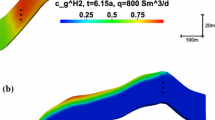A mathematical model of confined combustion of a gas hydrate has been presented that assumes full evaporation of water on the "hydrate–gas" boundary. In accordance with this assumption, the processes of diffusion of the gas through a liquid layer and the formation of a foam structure are excluded from the theoretical model, which leads to its significant simplification. The influence of the transfer coefficient on the temperature and concentration fields of the components of the gas mixture, and also their action on the intensity of decomposition of the gas hydrate have been analyzed based on numerical calculations. It has been established that both the intensity of combustion of methane and the intensity of decomposition of the gas hydrate grow with increase in the values of transfer coefficients. Here, the speed of decomposition of the gas hydrate decreases with time. It has been shown that in the case of confined combustion a burnout regime is likely to occur, with the hydrate decomposition occurring due to the heat stored in the gas mixture.
Similar content being viewed by others
References
C. Cranganu, In-situ thermal stimulation of gas hydrates, J. Pet. Sci. Eng., 65, 76–80 (2009).
W. C. Pfefferle, By Dissociating Methane Hydrate Deposits In-situ Wherein an Oxidizer Fluid and a Supply of Fuel, Both at a Pressure Higher Than That of the Methane Hydrate Deposit Are Delivered Downhole and Combusted, with Heat of Reaction Dissociating the Methane. Method of Natural Gas Production, US Patent No. 6973968 (2005).
V. E. Nakoryakov, S. Y. Misyura, S. L. Elistratov, A. Y. Manakov, and A. A. Sizikov, Methane combustion in hydrate systems: Water–methane and water–methane–isopropanol, J. Eng. Thermophys., 22, 169–173 (2013).
M. Roshandell, J. Santacana-Vall, S. Karnani, J. Botimer, P. Taborek, and D. Dunn-Rankin, Burning ice-direct combustion of methane clathrates, Combust. Sci. Technol., 188, Nos. 11–12, 2137–2148 (2016).
H. Kaneko, T. Okui, and H. Kagami, The combustion of methane hydrate, Proc. 35th Symp. (Japanese) on Combustion, pp. 462–464 (1997).
Y. Kitamura, K. Nakajo, and T. Ueda, Numerical calculation of a diffusion flame formed in the laminar boundary layer over methane-hydrate, Proc. 4th Int. Conf. on Gas Hydrate 4, pp. 1055–1058 (2002).
Y. Maruyama, M. J. Fuse, T. Yokomori, R. Ohmura, S. Watanabe, T. Iwasaki, W. Iwabuchi, and T. Ueda, Experimental investigation of flame spreading over pure methane hydrate in a laminar boundary layer, Proc. Combust. Inst., 34, 2131–2138 (2013).
Y. Nakamura, R. Katsuki, T. Yokomori, R. Ohmura, M. Takahashi, T. Iwasaki, K. Uchida, and T. Ueda, Combustion characteristics of methane hydrate in a laminar boundary layer, Energy Fuels, 23, 1445–1449 (2009).
T. Yoshioka, M. Suemitsu, T. Yokomori, R. Ohmura, and T. Ueda, Flame propagation over a methane hydrate with surface temperature variation in a natural convective flow field, Mech. Eng. Lett., 1, 15–00370 (2015).
X.-R. Chen, X.-S. Li, Zh. Chen, Y. Zhang, K.-F. Yan, and Q.-N. Lv, Experimental investigation into the combustion characteristics of propane hydrates in porous media, Energies, 8, 1242–1255 (2015).
T. Bar-Kohany and W. A. Sirignano, Transient combustion of a methane-hydrate sphere, Combust. Flame, 163, 284–300 (2016).
Y. Dagan and T. Bar-Kohany, Flame propagation through three-phase methane-hydrate particles, Combust. Flame, 193, 25–35 (2018).
Y-C. Chien and D. Dunn-Rankin, Combustion characteristics of methane hydrate fl ames, Energies, 12, No. 10, 1939 (2019).
D. C. Wilcox, Turbulence Modeling for CFD, 5354 Palm Drive, DCW Industries, Inc., La Canada, California (1998).
B. F. Magnussen and B. H. Hjertager, On the mathematical modelling of turbulent combustion with special emphasis on soot formation and combustion, Sixteenth Symp. (Int.) on Combustion, The Combustion Institute, Pittsburgh, PA (1977), pp. 719–729.
R. I. Nigmatulin, Dynamics of Multiphase Media, Part 1 [in Russian], Nauka, Moscow (1987).
O. M. Belotserkovskii and Yu. M. Davydov, Large-Particle Method in Gas Dynamics [in Russian], Nauka, Moscow (1982).
Author information
Authors and Affiliations
Corresponding author
Additional information
Translated from Inzhenerno-Fizicheskii Zhurnal, Vol. 95, No. 3, pp. 605–613, May–June, 2022.
Rights and permissions
About this article
Cite this article
Gimaltdinov, I.K., Bayanov, I.M., Stolpovskii, M.V. et al. On the Confined Combustion of a Hydrate. J Eng Phys Thermophy 95, 591–598 (2022). https://doi.org/10.1007/s10891-022-02515-w
Received:
Published:
Issue Date:
DOI: https://doi.org/10.1007/s10891-022-02515-w




